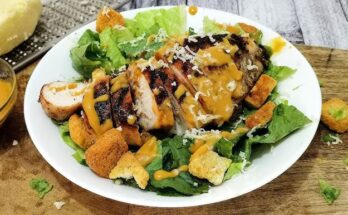Lemon Bars Recipe: Lemon bars are the perfect blend of a buttery shortbread crust and a tangy lemon filling. They’re easy to make, incredibly refreshing, and a go-to dessert for any occasion.
Whether you’re looking to bake these for a summer party, a family gathering, or just a delightful homemade treat, this guide will walk you through each step of creating the ultimate lemon bars.
Ingredients for Lemon Bars
Essential Ingredients
To make lemon bars, you’ll need a few simple ingredients that come together beautifully:
- All-Purpose Flour – For the crust, giving it a solid but tender base.
- Butter – The key to a rich, melt-in-your-mouth crust.
- Sugar – Adds sweetness to both the crust and the lemon layer.
- Lemon Juice and Zest – For that signature tangy lemon flavor.
- Eggs – Adds structure to the lemon filling, creating a custardy texture.
- Salt – Balances flavors in both the crust and the filling.
Ingredient Substitutions
If you’re missing any of the ingredients or have dietary needs, here are a few swaps to consider:
- Gluten-Free Flour can replace regular flour to make gluten-free lemon bars.
- Coconut Sugar or Stevia for a lower glycemic option.
- Coconut Oil can be used instead of butter for a dairy-free version.
Tools and Equipment Needed
Kitchen Tools Required
To make this recipe, you’ll need a few essential kitchen tools:
- Mixing Bowls – One for the crust and one for the filling.
- Baking Pan – An 8×8-inch pan is ideal, though you can use a larger one for thinner bars.
- Whisk and Spatula – For mixing the ingredients smoothly.
- Zester – To zest the lemon, as it adds a concentrated citrus flavor.
Optional Equipment for Best Results
- Parchment Paper – Helps to lift the bars easily from the pan.
- Cooling Rack – Allows air circulation for quicker cooling.
- Sharp Knife – For cleanly slicing the bars once they’re set.
How to Make Lemon Bars: Step-by-Step Guide
Step 1: Preparing the Crust
- Preheat the Oven to 350°F (175°C).
- Mix the Crust Ingredients – In a mixing bowl, combine flour, sugar, salt, and melted butter. Stir until the mixture resembles wet sand.
- Press into the Pan – Transfer the crust mixture into the baking pan, pressing it evenly across the bottom to form a compact layer.
- Bake – Place in the oven for 15-20 minutes, or until the edges turn a light golden brown.
Step 2: Making the Lemon Filling
- Whisk Eggs and Sugar – In a separate bowl, whisk together the eggs and sugar until smooth and frothy.
- Add Lemon Juice and Zest – Mix in fresh lemon juice and zest, followed by a small amount of flour. This will help thicken the filling.
- Combine until Smooth – Stir until the mixture is silky and evenly combined.
Step 3: Baking the Lemon Bars
- Pour Filling Over Baked Crust – Once the crust is baked, pour the lemon mixture over it.
- Bake Again – Return the pan to the oven and bake for another 20-25 minutes or until the filling is set but still slightly jiggly in the center.
- Cool – Allow the lemon bars to cool in the pan before transferring to a cooling rack.
Step 4: Cooling and Setting the Bars
- Cool Completely – Let the bars cool completely in the pan before slicing.
- Refrigerate – For clean cuts, chill the bars in the refrigerator for at least an hour.
- Dust with Powdered Sugar – Just before serving, dust with powdered sugar for a classic finishing touch.
Step-by-Step Details for Each Phase
Tips for the Perfect Crust
- Chill the Crust – For a firmer base, some bakers like to chill the crust mixture before baking.
- Use Even Pressure – Press the crust mixture evenly into the pan to ensure it bakes uniformly.
Tips for Tangy Lemon Filling
- Fresh Lemons Only – Always use freshly squeezed lemon juice and zest for the best flavor.
- Don’t Overbake – Bake the filling just until set to maintain a soft, custardy texture.
Avoiding Common Baking Mistakes
- Soggy Crust – Bake the crust until golden brown to prevent sogginess.
- Thin or Thick Filling – Adjust pan size to achieve desired thickness for the filling.
How to Serve Lemon Bars
Serving Suggestions
Lemon bars are best served slightly chilled. You can serve them as squares or triangles, and they pair well with fresh berries, whipped cream, or a drizzle of chocolate for a gourmet twist.
Garnishing Ideas
For a touch of color and flavor, garnish with a bit of lemon zest, fresh mint leaves, or edible flowers. Dusting with powdered sugar just before serving adds a beautiful finish.
Storing and Freezing Lemon Bars
How to Store Leftovers
Store leftover lemon bars in an airtight container in the refrigerator. They’ll stay fresh for up to 4 days and retain their texture when kept cool.
Freezing Instructions
Lemon bars freeze well, making them ideal for preparing in advance. Wrap each bar individually in plastic wrap, place them in a freezer-safe container, and store them for up to three months.
Popular Variations of Lemon Bars
Gluten-Free Lemon Bars
Swap out the all-purpose flour with a gluten-free blend for a gluten-free version. Adjust the baking time as necessary for a similar texture.
Vegan Lemon Bars
Use flax eggs and dairy-free butter for a vegan alternative. Coconut milk can also add a creamy texture to the filling.
Keto Lemon Bars
Substitute almond flour for the crust and use a low-carb sweetener like erythritol to keep this dessert keto-friendly.
Health Benefits of Lemon Bars
Nutritional Profile
Lemon bars contain essential vitamins and minerals, including Vitamin C from the lemon juice and calcium from the eggs.
Benefits of Lemons and Other Ingredients
Lemons are rich in antioxidants and Vitamin C, known for immune-boosting and skin-clearing properties. Eggs provide protein and other nutrients essential for a balanced diet.
FAQs about Lemon Bars Recipe
Q1: What are lemon bars made of?
Lemon bars typically consist of a buttery shortbread crust topped with a tangy lemon filling. The filling is made with lemon juice, sugar, eggs, and a bit of flour to give it a smooth, custard-like texture.
Q2: Can I use bottled lemon juice instead of fresh?
Yes, bottled lemon juice can be used if fresh lemons aren’t available. However, fresh lemon juice provides a brighter, more natural flavor, which enhances the overall taste of the lemon bars.
Q3: How do I prevent my lemon bars from being too runny?
To avoid runny lemon bars, ensure you measure your ingredients accurately, especially the flour and sugar. Baking the bars at the correct temperature and allowing them to set after baking will also help achieve the right texture.
Q4: How long do lemon bars last?
When stored in an airtight container in the refrigerator, lemon bars can last for up to 4-5 days. They can also be frozen for longer storage; just wrap them tightly before freezing.
Q5: Can I make lemon bars gluten-free?
Absolutely! Substitute the regular flour with a gluten-free flour blend to make a gluten-free version of lemon bars. Be sure to check if your ingredients, such as the gluten-free flour, are certified gluten-free if you have dietary restrictions.
Q6: Why do my lemon bars have bubbles on top?
Bubbles can form if the filling mixture is whipped too vigorously, introducing air into the mixture. To prevent bubbles, mix the filling gently until just combined.
Q7: How do I get clean slices of lemon bars?
For clean cuts, chill the lemon bars in the fridge for an hour or two before slicing. Use a sharp knife and wipe it clean between cuts for the best results.
Conclusion
Making lemon bars from scratch is simple, and the result is a delightful dessert that offers the perfect blend of tangy and sweet. Whether for a special occasion or an everyday treat, these lemon bars are sure to impress. Enjoy experimenting with different variations and serve them up with confidence, knowing you’ve created something delicious!



